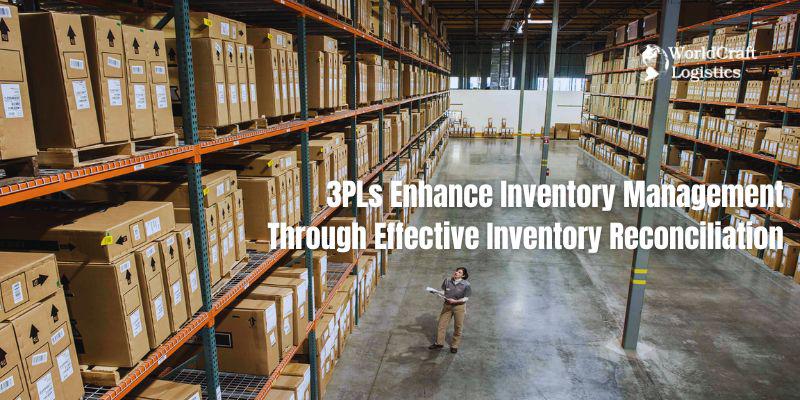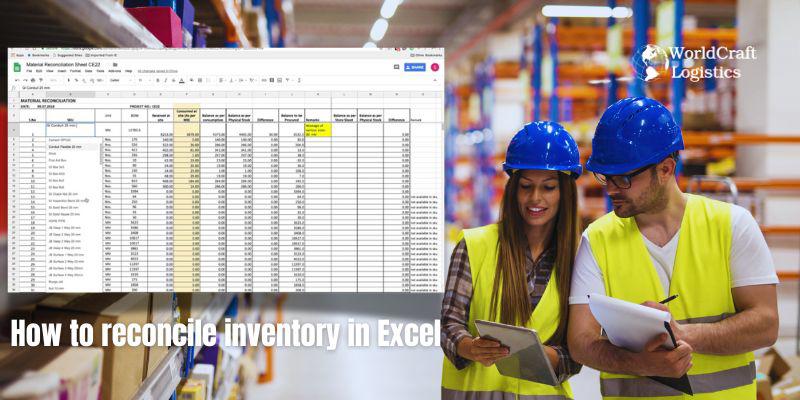
Starting June 1st, 2023 Our warehouse fee will be $0.65/cubic foot per month
In effort to lower the warehouse storage fee during inflation, we have went narrow aisle racking.This construction took us four months but the project is finally completed. With narrow aisle racking, we are able to drop storage by 24%.We as partners will go through this inflation together.
10/15/2024
Effective inventory reconciliation is crucial for business owners who want to ensure their customers receive exactly what they need, when they need it.
In today’s fast-paced retail landscape, maintaining accurate inventory levels is more critical than ever. Recent data from 2023 highlights that discrepancies between recorded inventory and actual stock levels remain a significant issue for many businesses.

In fact, the National Retail Federation reports that inventory shrinkage in the U.S. has contributed to staggering losses, amounting to over $94.5 billion in 2022. Even industry giants are not immune to these challenges.
So, how can you safeguard your business against such costly mistakes? The answer lies in implementing a robust inventory reconciliation process. Join Worldcraft Logistics as we explore the vital steps to achieve precise inventory management and enhance customer satisfaction.
Inventory reconciliation is the process of comparing and verifying the quantities of physical inventory against the records maintained in an inventory management system. This ensures that the actual stock levels match the quantities recorded, helping businesses identify discrepancies, inaccuracies, or losses.

Inventory reconciliation can often be a tedious and time-consuming exercise, especially for small and medium-sized enterprises. These businesses may find themselves needing to shut down operations for a few days or extend working hours to conduct a thorough count of physical inventory. To alleviate this burden, some companies adopt a strategy known as "cycle counting," which allows them to spread the inventory reconciliation process over an extended period. This method makes it easier for staff to manage their workload while ensuring that all inventory is checked and counted accurately.
Cycle counting can also be significantly enhanced through automation and integration with advanced inventory management software. By utilizing barcode scanners and point-of-sale systems, businesses can streamline the counting process, minimizing manual effort and reducing human error. This technological integration not only expedites the reconciliation process but also provides real-time inventory data, allowing businesses to maintain more accurate records without the disruptions typically associated with traditional inventory counts.
Another effective approach to inventory reconciliation is to prioritize the counting process by categorizing products into groups A, B, and C based on their value. Category A includes high-value inventory, such as top-selling items, which have a greater impact on the business and are counted more frequently. In contrast, moderate and low-value inventory is categorized as B and C, respectively, and counted less often. This prioritization ensures that businesses focus their resources on the most critical inventory items, enhancing accuracy and efficiency in the overall reconciliation process.

Read more:
👉 Inventory Visibility: 6 Benefits & Solutions to Your Supply Chain
👉 Inventory Pooling: Benefits, Problems & Best Advice For You
Inventory reconciliation can present significant challenges for businesses. The process of counting stock and verifying these figures against the inventory levels in your POS system requires careful organization, dedication, and a commitment to allocating sufficient time for completion. To streamline this task, consider following these six essential steps to ensure a thorough and accurate reconciliation.

Before beginning the inventory count, ensure that all necessary tools and resources are in place. This includes organizing the inventory area, ensuring that counting equipment (like barcode scanners or counting sheets) is ready, and notifying staff of the counting schedule. Preparing a checklist of items to be counted can also help streamline the process.
Perform a physical count of your inventory by systematically going through the stock. Depending on the size of your operation, you can either count everything at once or implement cycle counting to spread the task over time. Make sure to involve staff members who are familiar with the inventory to minimize errors during the counting process.
As you count the inventory, carefully record the quantities on your counting sheets or directly into your inventory management software. Accuracy is crucial, so double-check entries to ensure they reflect the physical count accurately. If using barcode scanners, confirm that all items are scanned correctly.
After completing the physical count, compare the recorded quantities against the inventory levels in your POS system. Identify any discrepancies between the two sets of data. This step is critical for understanding where inaccuracies may have occurred and for taking corrective action.
For any discrepancies found, conduct a thorough investigation to determine the cause. This may involve checking for administrative errors, reviewing sales records, or assessing potential shrinkage due to theft or damage. Understanding the root cause of discrepancies will help you address issues effectively and prevent future occurrences.
Once discrepancies are resolved, update your inventory records to reflect the accurate counts. This may involve making adjustments in your inventory management system to ensure that stock levels are correct. Regularly updating records and monitoring inventory will help maintain accuracy and improve overall inventory management.
By following these six steps, businesses can effectively perform inventory reconciliation, leading to enhanced accuracy, better decision-making, and increased operational efficiency.

Inventory reconciliation is essential for businesses to ensure accurate stock levels and mitigate discrepancies. Here are 5 effective methods to streamline the inventory reconciliation process:
Cycle counting is a systematic approach to inventory reconciliation where a portion of the inventory is counted on a regular basis throughout the year. Instead of shutting down operations for a full inventory count, businesses can break the counting process into manageable segments. This method helps identify discrepancies more frequently and ensures that stock levels remain accurate over time.
Implementing barcoding or RFID technology can significantly streamline the inventory reconciliation process. By equipping products with barcodes or RFID tags, businesses can easily track stock levels and perform quick scans during counts. This technology reduces human error, speeds up the counting process, and provides real-time inventory data, making it easier to maintain accurate records.
The ABC method categorizes inventory into three groups based on value and turnover rate. Category A includes high-value items that require more frequent counting, while Category B and C comprise moderate and low-value items, respectively. By focusing on high-value inventory more often, businesses can prioritize their resources and attention where they matter most, enhancing overall accuracy in inventory management.
Conducting annual inventory audits involves a comprehensive count of all stock at least once a year. This method provides a thorough overview of inventory levels and can help identify larger discrepancies that might have accumulated over time. Annual audits are essential for compliance and for businesses seeking to refine their inventory management practices.
Performing random checks is an effective way to maintain inventory accuracy between scheduled counts. By selecting random items or sections of inventory to count periodically, businesses can detect discrepancies that might otherwise go unnoticed. This method promotes accountability among staff and ensures that inventory records remain reliable throughout the year.
By employing these five effective methods, businesses can enhance their inventory reconciliation processes, leading to improved accuracy, reduced losses, and better overall inventory management.

Inventory reconciliation is an essential activity for businesses looking to optimize operations and improve overall performance. By maintaining accurate inventory records, companies can enjoy a number of significant benefits that contribute to their success. Here are nine significant benefits:
Regular inventory reconciliation helps ensure that recorded stock levels match actual inventory. This accuracy minimizes discrepancies that can lead to stockouts or overstocking, enabling businesses to make informed decisions based on reliable data.
Accurate inventory records contribute to better financial management. By understanding stock levels and turnover rates, businesses can optimize purchasing decisions, reduce carrying costs, and ultimately improve their bottom line.
Maintaining accurate inventory levels ensures that businesses can fulfill customer orders promptly. When customers receive their products on time and as expected, it enhances their overall experience and fosters brand loyalty.
Regular reconciliation can help identify issues such as theft, damage, or administrative errors early on. By addressing these problems promptly, businesses can reduce inventory losses and protect their assets.
Inventory reconciliation promotes a more organized and efficient inventory management process. With accurate records, businesses can streamline order fulfillment, improve stock rotation, and optimize warehouse space, leading to enhanced operational efficiency.
Accurate inventory data facilitates better communication with suppliers and enables businesses to manage their supply chains more effectively. By understanding inventory needs and turnover rates, companies can negotiate better terms, forecast demand accurately, and avoid disruptions.
Many industries require businesses to maintain accurate inventory records for compliance purposes. Regular inventory reconciliation helps ensure adherence to these regulations, reducing the risk of penalties or legal issues.
Reliable inventory data allows businesses to make strategic decisions regarding pricing, promotions, and product lines. By understanding inventory performance, companies can tailor their strategies to meet market demands effectively.
In summary, inventory reconciliation is a vital practice that offers numerous benefits, from enhancing accuracy and improving financial performance to increasing customer satisfaction and streamlining operations. Regularly reconciling inventory ensures that businesses remain competitive and efficient in today’s fast-paced market.
Aspect | Perpetual Inventory | Reconciliation Report |
Definition | A continuous inventory tracking system that updates inventory levels in real-time as transactions occur. | A document that compares physical inventory counts with recorded inventory levels to identify discrepancies. |
Purpose | To maintain accurate, up-to-date inventory records at all times, facilitating immediate access to inventory data. | To verify the accuracy of inventory records, identify errors, and adjust discrepancies between physical counts and recorded levels. |
Frequency of Updates | Updates occur continuously with each sale, purchase, or return, providing real-time visibility. | Conducted periodically (e.g., monthly, quarterly) or annually to assess overall inventory accuracy. |
Data Management | Relies on integrated systems (like POS or inventory management software) for real-time data updates. | Often involves manual counting and data entry to create reports, especially during audits. |
Usage | Primarily used in businesses with high transaction volumes that require immediate inventory information. | Used for validating inventory accuracy, especially during audits, financial reporting, or identifying shrinkage. |
Advantages | Enhances decision-making with real-time data, reduces stockouts, and improves inventory control. | Helps ensure financial accuracy, minimizes losses due to discrepancies, and provides insights for inventory management improvements. |
Challenges | Can be complex to implement and maintain; requires robust technology and training. | Time-consuming to prepare and may reveal significant discrepancies that need thorough investigation. |

Third-party logistics providers (3PLs) same as Worldcraft Logistics play a crucial role in enhancing inventory management by implementing effective inventory reconciliation processes. By leveraging their expertise and advanced technologies, 3PLs help businesses maintain accurate inventory records, reduce discrepancies, and optimize stock levels.
Effective inventory reconciliation allows 3PLs to identify variances between physical inventory and recorded data quickly. This process involves regular physical counts, automated data tracking, and thorough analysis of discrepancies. With accurate inventory records, businesses can avoid stockouts, reduce excess inventory, and improve overall efficiency in their supply chain.
Moreover, 3PLs utilize sophisticated inventory management software and data analytics tools to provide real-time insights into inventory levels and trends. This enables companies to make informed decisions about purchasing, stocking, and fulfilling customer orders. By streamlining inventory reconciliation, 3PLs not only enhance operational efficiency but also contribute to better customer satisfaction through timely and accurate order fulfillment.
Background: Fashion Forward, a retail clothing store, conducts quarterly inventory reconciliation to ensure accurate stock levels.
Process:
Physical Count: The store staff counts all clothing items, shoes, and accessories on a designated day, recording the numbers on tally sheets.
Data Comparison: After the count, the manager compares the physical totals with the recorded inventory in the management system. For example, the recorded inventory shows 500 dresses, while the count reveals only 450.
Discrepancy Investigation: The team identifies that 30 dresses were misplaced during a display change and 20 were sold but not logged due to a POS error.
Adjustment: They adjust the inventory records to reflect the accurate count of 450 dresses.
Outcome: By conducting this reconciliation, Fashion Forward improved inventory accuracy, reduced losses, and enhanced customer satisfaction by ensuring the right products were available.
Background: ABC Electronics, a warehouse that specializes in consumer electronics, conducts monthly inventory reconciliation to maintain accurate stock levels.
Process:
Physical Count: At the end of the month, warehouse staff conducts a physical count of all electronics, such as TVs, laptops, and accessories.
Data Comparison: After counting, the manager compares the physical inventory totals with the records in the inventory management system. For instance, the system shows 1,200 laptops, but the physical count reveals only 1,150.
Discrepancy Investigation: Upon investigation, the team finds that 30 laptops were damaged during shipping, and 20 were not entered into the system after a recent sale.
Adjustment: The inventory records are updated to accurately reflect the count of 1,150 laptops.
Outcome: This reconciliation process allows ABC Electronics to reduce stock discrepancies, enhance operational efficiency, and ensure that they can meet customer demands effectively.
Utilize Technology: Invest in inventory management software that integrates with your POS system. This can automate many reconciliation tasks, reduce human error, and provide real-time data updates, making the process more efficient.
Implement Cycle Counting: Instead of performing a full inventory count annually, consider cycle counting, where different sections of inventory are counted regularly throughout the year. This keeps your inventory data accurate and up-to-date without overwhelming your staff.
Prioritize High-Value Items: Focus your reconciliation efforts on high-value or fast-moving items. Regularly checking these items can help you quickly identify discrepancies and prevent significant losses.
Standardize Procedures: Establish clear and consistent procedures for inventory counting and reconciliation. Train your staff on these procedures to ensure everyone is on the same page and understands the importance of accuracy.
Cross-Check with Sales Data: Compare your inventory counts with sales data to identify patterns or discrepancies. If certain items are selling faster than recorded, it may indicate issues with stock logging or theft.
Use Barcoding and RFID: Implement barcoding or RFID technology to streamline the counting process. Scanning items can significantly reduce counting time and improve accuracy, allowing for more frequent reconciliations.
Conduct Surprise Audits: Schedule random inventory audits throughout the year. These surprise checks can help ensure that staff consistently follow inventory procedures and can reveal any ongoing discrepancies.
Encourage Employee Accountability: Make inventory management a shared responsibility among staff. When employees are accountable for their sections, they are more likely to maintain accurate inventory levels.
Document Everything: Keep thorough records of all inventory counts, discrepancies, and adjustments made. This documentation can help track patterns over time and identify areas for improvement in your inventory processes.
Review and Adjust Regularly: Finally, regularly review your reconciliation processes and make adjustments as necessary. Continuous improvement can help enhance the accuracy and efficiency of your inventory management efforts.
By implementing these tips, businesses can improve their inventory reconciliation processes, reduce discrepancies, and ensure they maintain optimal stock levels.
To reconcile inventory in Excel, start by creating a spreadsheet with two columns: one for your physical count and another for your recorded inventory levels from your inventory management system. Use formulas to calculate discrepancies by subtracting the recorded level from the physical count. Highlight any significant discrepancies for further investigation and document any adjustments made.

To reconcile the ending inventory balance, compare your physical inventory count with the recorded balance in your accounting system. Identify any discrepancies, investigate their causes (such as theft, damage, or errors), and make necessary adjustments to reflect the accurate ending balance. This process ensures that your financial statements accurately represent your inventory.
The scope of inventory reconciliation includes verifying and adjusting inventory records to ensure accuracy between physical counts and recorded data. It encompasses all inventory items, including raw materials, work-in-progress, and finished goods. The process also involves identifying discrepancies, determining their causes, and implementing measures to improve inventory management.
There are several types of inventory reconciliation, including:
Periodic Reconciliation: Conducted at regular intervals (monthly, quarterly, or annually) to verify inventory levels.
Cycle Counting: Ongoing counts of a portion of inventory on a regular basis, focusing on high-value or fast-moving items.
Annual Inventory Audit: A comprehensive count conducted once a year, often required for financial reporting.
Random Audits: Surprise counts that assess the accuracy of inventory records without prior notice.
To adjust inventory balance, first identify discrepancies between the physical count and the recorded inventory levels. Once the causes of these discrepancies are determined, update your inventory management system to reflect the accurate count. This may involve adding or removing items from the inventory records and documenting the reasons for the adjustments for future reference.
SEO
Digital Marketing/SEO Specialist
Simon Mang is an SEO and Digital Marketing expert at Wordcraft Logistics. With many years of experience in the field of digital marketing, he has shaped and built strategies to effectively promote Wordcraft Logistics' online presence. With a deep understanding of the logistics industry, I have shared more than 500 specialized articles on many different topics.

Education
01/05/2025

Education
02/18/2025

Education
01/01/2024

Education
08/28/2024

Education
11/13/2023